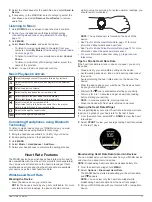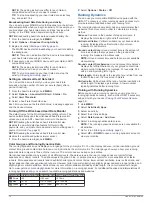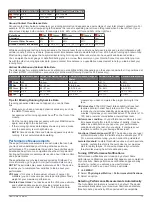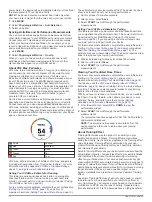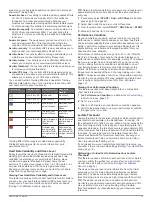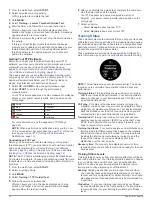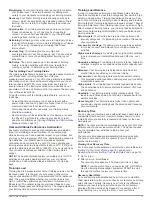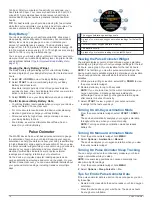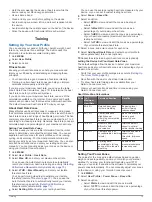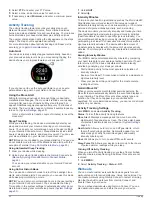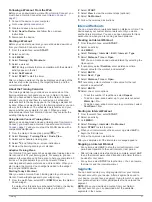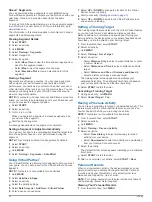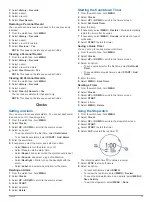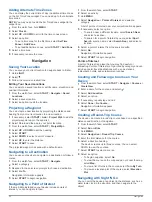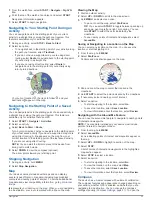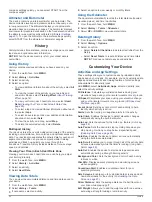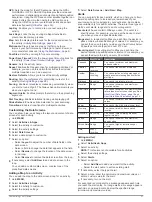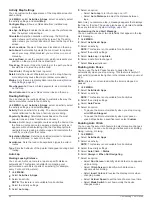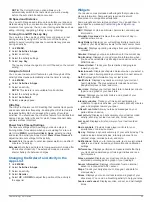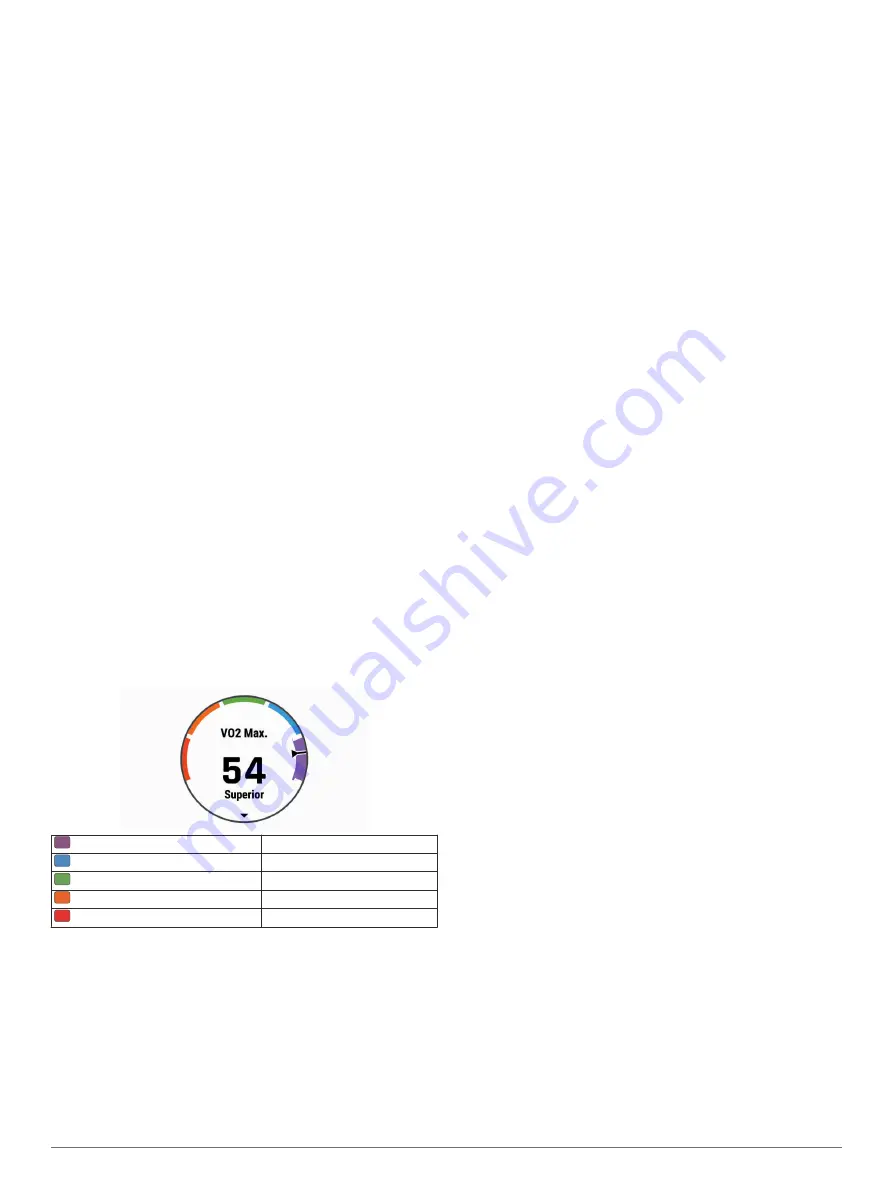
power meter, the device can automatically detect your functional
threshold power (FTP) during an activity.
NOTE:
The device detects a maximum heart rate only when
your heart rate is higher than the value set in your user profile.
1
Hold
MENU
.
2
Select
Physiological Metrics
>
Auto Detection
.
3
Select an option.
Syncing Activities and Performance Measurements
You can sync activities and performance measurements from
other Garmin devices to your MARQ device using your Garmin
Connect account. This allows your device to more accurately
reflect your training status and fitness. For example, you can
record a ride with an Edge device, and view your activity details
and overall training load on your MARQ device.
1
Hold
MENU
.
2
Select
Physiological Metrics
>
TrueUp
.
When you sync your device with your smartphone, recent
activities and performance measurements from your other
Garmin devices appear on your MARQ device.
About VO2 Max. Estimates
VO2 max. is the maximum volume of oxygen (in milliliters) you
can consume per minute per kilogram of body weight at your
maximum performance. In simple terms, VO2 max. is an
indication of athletic performance and should increase as your
level of fitness improves. The MARQ device requires wrist-
based heart rate or a compatible chest heart rate monitor to
display your VO2 max. estimate. The device has separate VO2
max. estimates for running and cycling. You must run either
outside with GPS or ride with a compatible power meter at a
moderate level of intensity for several minutes to get an
accurate VO2 max. estimate.
On the device, your VO2 max. estimate appears as a number,
description, and position on the color gauge. On your Garmin
Connect account, you can view additional details about your
VO2 max. estimate, including your fitness age. Your fitness age
gives you an idea of how your fitness compares with a person of
the same gender and different age. As you exercise, your fitness
age can decrease over time.
Purple
Superior
Blue
Excellent
Green
Good
Orange
Fair
Red
Poor
VO2 max. data is provided by FirstBeat. VO2 max. analysis is
provided with permission from The Cooper Institute
®
. For more
information, see the appendix (
), and go to
Getting Your VO2 Max. Estimate for Running
This feature requires wrist-based heart rate or a compatible
chest heart rate monitor. If you are using a chest heart rate
monitor, you must put it on and pair it with your device (
).
For the most accurate estimate, complete the user profile setup
(
), and set your
maximum heart rate (
).
The estimate may seem inaccurate at first. The device requires
a few runs to learn about your running performance.
1
Run for at least 10 minutes outdoors.
2
After your run, select
Save
.
3
Select
START
to scroll through the performance
measurements.
Getting Your VO2 Max. Estimate for Cycling
This feature requires a power meter and wrist-based heart rate
or a compatible chest heart rate monitor. The power meter must
be paired with your MARQ device (
). If you are using a chest heart rate monitor,
you must put it on and pair it with your device.
For the most accurate estimate, complete the user profile setup
(
) and set your maximum
heart rate (
). The
estimate may seem inaccurate at first. The device requires a few
rides to learn about your cycling performance.
1
Ride at a steady, high intensity for at least 20 minutes.
2
After your ride, select
Save
.
3
Select
START
to scroll through the performance
measurements.
Viewing Your Predicted Race Times
For the most accurate estimate, complete the user profile setup
(
), and set your
maximum heart rate (
).
Your device uses the VO2 max. estimate (
) and your training history to provide a target
race time. The device analyzes several weeks of your training
data to refine the race time estimates.
TIP:
If you have more than one Garmin device, you can enable
the Physio TrueUp
™
feature, which allows your device to sync
activities, history, and data from other devices (
Activities and Performance Measurements
).
1
From the watch face, select
UP
or
DOWN
to view the
performance widget.
2
Select
START
to scroll through the performance
measurements.
Your projected race times appear for 5K, 10K, half marathon,
and marathon distances.
NOTE:
The projections may seem inaccurate at first. The
device requires a few runs to learn about your running
performance.
About Training Effect
Training Effect measures the impact of an activity on your
aerobic and anaerobic fitness. Training Effect accumulates
during the activity. As the activity progresses, the Training Effect
value increases. Training Effect is determined by your user
profile information and training history, and heart rate, duration,
and intensity of your activity.
Aerobic Training Effect uses your heart rate to measure how the
accumulated intensity of an exercise affects your aerobic fitness
and indicates if the workout had a maintaining or improving
effect on your fitness level. Your excess post-exercise oxygen
consumption (EPOC) accumulated during exercise is mapped to
a range of values that account for your fitness level and training
habits. Steady workouts at moderate effort or workouts involving
longer intervals (>180 sec) have a positive impact on your
aerobic metabolism and result in an improved aerobic Training
Effect.
Anaerobic Training Effect uses heart rate and speed (or power)
to determine how a workout affects your ability to perform at
very high intensity. You receive a value based on the anaerobic
contribution to EPOC and the type of activity. Repeated high-
intensity intervals of 10 to 120 seconds have a highly beneficial
14
Heart Rate Features
Summary of Contents for MARQ DRIVER
Page 1: ...MARQ DRIVER Owner sManual ...
Page 6: ......
Page 51: ......
Page 52: ...support garmin com March 2019 190 02359 00_0A ...












